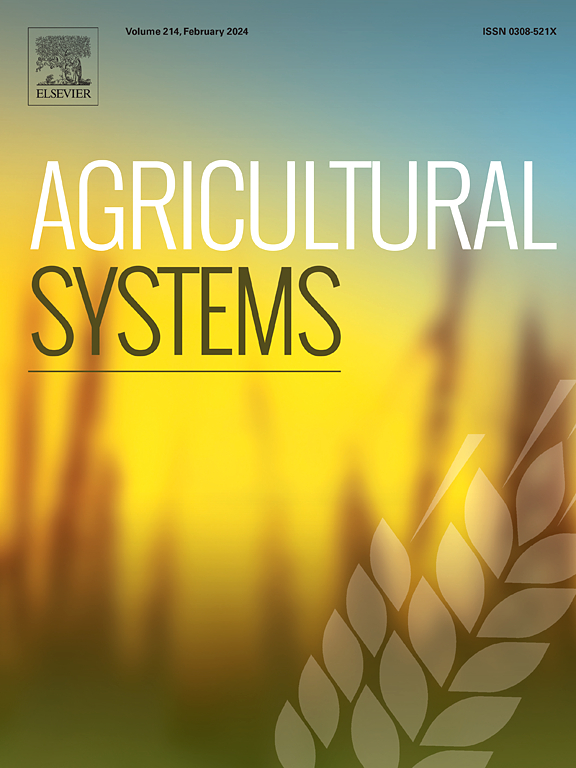Characterization of common bean production regions in Brazil using machine learning techniques
IF 6.1
1区 农林科学
Q1 AGRICULTURE, MULTIDISCIPLINARY
引用次数: 0
Abstract
PROBLEM
Understanding the interactions between genotype, environment, and management is crucial for guiding the development of new cultivars and defining strategies to maximize yield under specific environmental conditions.
OBJECTIVE
This study aimed to classify and characterize homogeneous production regions for common beans in Brazil by leveraging simulated yield data and machine learning techniques. The goal was to identify the environmental factors that define these homogeneous regions and to develop a spatiotemporal sowing calendar for rainfed (wet and dry seasons) and irrigated (winter season) production.
METHODS
The CSM-CROPGRO-Dry Bean model was used to simulate the yield of common beans in Brazilian municipalities during the wet (rainfed) season (sowing between August and December - 275 municipalities), dry (rainfed) season (sowing between January and April - 251 municipalities) and winter (irrigated) season (sowing between April and July - 59 municipalities), utilizing soil data, daily climate data (1980 to 2016), management information (sowing date and irrigation/rainfed), and genetic coefficients to reflect the performance of the BRS Estilo cultivar related to phenology, growth and yield components. To create homogeneous environmental groups and associate them with specific environmental features, we applied machine learning techniques, including K-means clustering and decision tree analysis.
RESULTS
According to the results, we identified three distinct homogeneous regions — high, medium, and low yields — for each cultivation season (wet, dry, and winter). During the wet season, regions with yields between 2326 and 3500 kg ha−1 were classified as high-yield, those between 1404 and 2325 kg ha−1 as medium-yield, and those between 500 and 1403 kg ha−1 as low-yield. In the dry season, high-yield regions had yields ranging from 2492 to 3500 kg ha−1, medium-yield regions from 1484 to 2491 kg ha−1, and low-yield regions from 500 to 1483 kg ha−1. For the winter season, high-yield regions achieved yields between 2972 and 3500 kg ha−1, medium-yield regions between 2252 and 2971 kg ha−1, and low-yield regions between 634 and 2251 kg ha−1. For rainfed seasons (wet and dry), the water stress (WSPD) had a greater impact on yield than air temperature and global solar radiation. While in the winter season, air temperature was the most relevant factor. Overall, in the wet season, delayed sowing contributed to increased yield, especially in the state of Paraná. In the dry season, delayed sowing caused a reduction in yield, particularly in the Midwest and Southeast regions. In the winter season, yield varied less significantly between sowing dates, except in the state of Mato Grosso, where harmful increases in air temperature were observed in the later months.
CONCLUSIONS
The integration of crop simulation models with machine learning tools is valuable for defining and characterizing homogeneous regions for common bean production. This approach has identified three distinct yield regions—high, medium, and low—for each crop season (wet, dry, and winter). By distinguishing these regions, this methodology supports breeding programs in developing cultivars optimized for specific environments and provides insights into how environmental factors influence crop performance. Additionally, it helps optimize sowing dates to align with favorable conditions, particularly during the wet and dry seasons, thereby contributing to reduced yield losses.
IMPLICATIONS
The classification and characterization of homogeneous production regions helps to better understand the genotype (G) x environment (E) x management (M) interactions and to adjust sowing dates to more favorable conditions, especially during the wet and dry seasons, contributing to reducing yield losses. Despite the limitations of crop modeling—such as not accounting for biotic factors and waterlogging—addressing water and air temperature stress presents an even greater challenge. In this context, crop modeling plays a crucial role in identifying effective adaptation strategies.

利用机器学习技术确定巴西普通豆类产区的特征
问题:了解基因型、环境和管理之间的相互作用对于指导新品种的开发和确定在特定环境条件下实现产量最大化的策略至关重要。本研究旨在利用模拟产量数据和机器学习技术对巴西普通豆的同质生产区进行分类和表征。目标是确定确定这些同质区域的环境因素,并为雨育(旱季和雨季)和灌溉(冬季)生产制定时空播种日历。方法采用csm - cropgro -干豆模型,利用土壤数据、日常气候数据(1980 - 2016)、管理信息(播种日期和灌溉/雨养)、土壤数据(8 - 12月播种- 275个城市)、干(雨养)季节(1 - 4月播种- 251个城市)和冬季(灌溉)季节(4 - 7月播种- 59个城市),模拟巴西各城市湿(雨养)季节普通豆的产量。和遗传系数来反映与物候、生长和产量有关的品种性能。为了创建同质环境组并将其与特定的环境特征相关联,我们应用了机器学习技术,包括K-means聚类和决策树分析。结果在每个栽培季节(湿季、干季和冬季),我们确定了三个不同的均匀区域——高、中、低产量。在丰水期,产量在2326 ~ 3500 kg ha - 1之间的区域被划分为高产区,1404 ~ 2325 kg ha - 1之间的区域被划分为中高产区,500 ~ 1403 kg ha - 1之间的区域被划分为低产区。旱季高产区产量为2492 ~ 3500 kg ha - 1,中产区产量为1484 ~ 2491 kg ha - 1,低产区产量为500 ~ 1483 kg ha - 1。在冬季,高产地区的产量在2972至3500公斤公顷- 1之间,中产区在2252至2971公斤公顷- 1之间,低产区在634至2251公斤公顷- 1之间。在旱季和雨季,水分胁迫对产量的影响大于气温和总太阳辐射。而在冬季,气温是最相关的因素。总体而言,在雨季,延迟播种有助于提高产量,特别是在帕拉纳州。在旱季,播种延迟导致产量下降,特别是在中西部和东南部地区。在冬季,除了马托格罗索州(Mato Grosso)以外,不同播种日期之间的产量变化不大,该州在播种后期观察到有害的气温上升。结论作物模拟模型与机器学习工具的集成对于确定和表征普通豆类生产的均匀区域是有价值的。这种方法确定了每个作物季节(湿、干和冬季)的三个不同的产量区域——高、中、低。通过区分这些区域,该方法支持培育适合特定环境的品种的育种计划,并提供了环境因素如何影响作物性能的见解。此外,它还有助于优化播种日期,以适应有利条件,特别是在湿季和旱季,从而有助于减少产量损失。同质产区的分类和特征有助于更好地了解基因型(G) x环境(E) x管理(M)的相互作用,并调整播种日期以适应更有利的条件,特别是在湿季和旱季,有助于减少产量损失。尽管作物模型存在局限性——比如没有考虑到生物因素和涝渍——但解决水和气温压力问题是一个更大的挑战。在这种情况下,作物模型在确定有效的适应策略方面起着至关重要的作用。
本文章由计算机程序翻译,如有差异,请以英文原文为准。
求助全文
约1分钟内获得全文
求助全文
来源期刊

Agricultural Systems
农林科学-农业综合
CiteScore
13.30
自引率
7.60%
发文量
174
审稿时长
30 days
期刊介绍:
Agricultural Systems is an international journal that deals with interactions - among the components of agricultural systems, among hierarchical levels of agricultural systems, between agricultural and other land use systems, and between agricultural systems and their natural, social and economic environments.
The scope includes the development and application of systems analysis methodologies in the following areas:
Systems approaches in the sustainable intensification of agriculture; pathways for sustainable intensification; crop-livestock integration; farm-level resource allocation; quantification of benefits and trade-offs at farm to landscape levels; integrative, participatory and dynamic modelling approaches for qualitative and quantitative assessments of agricultural systems and decision making;
The interactions between agricultural and non-agricultural landscapes; the multiple services of agricultural systems; food security and the environment;
Global change and adaptation science; transformational adaptations as driven by changes in climate, policy, values and attitudes influencing the design of farming systems;
Development and application of farming systems design tools and methods for impact, scenario and case study analysis; managing the complexities of dynamic agricultural systems; innovation systems and multi stakeholder arrangements that support or promote change and (or) inform policy decisions.
 求助内容:
求助内容: 应助结果提醒方式:
应助结果提醒方式:


